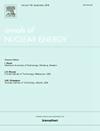Effect of surface oxidation on minimum film boiling temperature during Zr-4 quenching process
IF 1.9
3区 工程技术
Q1 NUCLEAR SCIENCE & TECHNOLOGY
引用次数: 0
Abstract
The minimum film boiling temperature is the impassable temperature point in the quenching transient, which indicates whether the fuel cladding surface is cooled effectively. Based on the Rayley-Taylor instability theory, this paper considers the influence of vapor–liquid interface fluctuation on the collapse of the vapor film during film boiling. The evaporation angle is introduced to quantify the intensity of vapor–liquid interface fluctuation, and the evaporation angle is connected with the wall hydrophilicity. The evaporation angle near the quench front is measured through the visual quenching experiment, and the contact angle of the Zr-4 surface is measured through the liquid drop experiment. The relationship between the evaperation angle of the vapor–liquid interface and the contact angle of the wall surface is obtained. The results show that surface oxidation can reduce the surface contact angle of Zr-4 alloy, which makes the vapor–liquid interface fluctuate more violently during quenching, and thus reduces the minimum film boiling temperature.
Zr-4淬火过程中表面氧化对最低膜沸腾温度的影响
最低汽膜沸腾温度是淬火瞬态不可通过的温度点,是燃料包壳表面是否得到有效冷却的标志。基于Rayley-Taylor不稳定性理论,考虑了气液界面波动对膜沸腾过程中汽膜坍塌的影响。引入蒸发角来量化气液界面波动强度,并将蒸发角与壁面亲水性联系起来。通过目测淬火实验测量淬火前附近的蒸发角,通过液滴实验测量Zr-4表面的接触角。得到了汽液界面蒸发角与壁面接触角的关系。结果表明:表面氧化使Zr-4合金表面接触角减小,使气液界面在淬火过程中波动更剧烈,从而降低了最低膜沸腾温度;
本文章由计算机程序翻译,如有差异,请以英文原文为准。
求助全文
约1分钟内获得全文
求助全文
来源期刊

Annals of Nuclear Energy
工程技术-核科学技术
CiteScore
4.30
自引率
21.10%
发文量
632
审稿时长
7.3 months
期刊介绍:
Annals of Nuclear Energy provides an international medium for the communication of original research, ideas and developments in all areas of the field of nuclear energy science and technology. Its scope embraces nuclear fuel reserves, fuel cycles and cost, materials, processing, system and component technology (fission only), design and optimization, direct conversion of nuclear energy sources, environmental control, reactor physics, heat transfer and fluid dynamics, structural analysis, fuel management, future developments, nuclear fuel and safety, nuclear aerosol, neutron physics, computer technology (both software and hardware), risk assessment, radioactive waste disposal and reactor thermal hydraulics. Papers submitted to Annals need to demonstrate a clear link to nuclear power generation/nuclear engineering. Papers which deal with pure nuclear physics, pure health physics, imaging, or attenuation and shielding properties of concretes and various geological materials are not within the scope of the journal. Also, papers that deal with policy or economics are not within the scope of the journal.
 求助内容:
求助内容: 应助结果提醒方式:
应助结果提醒方式:


